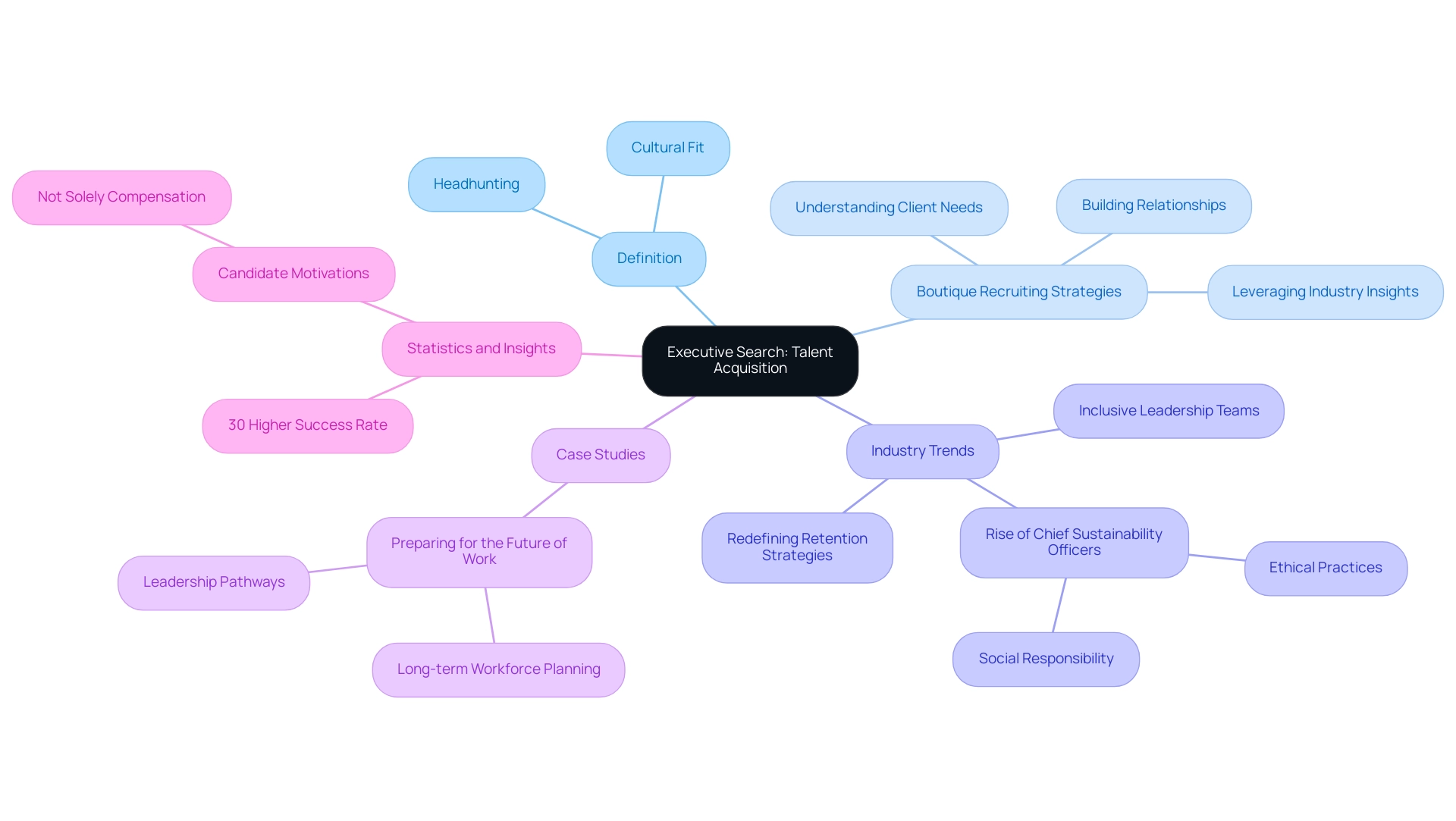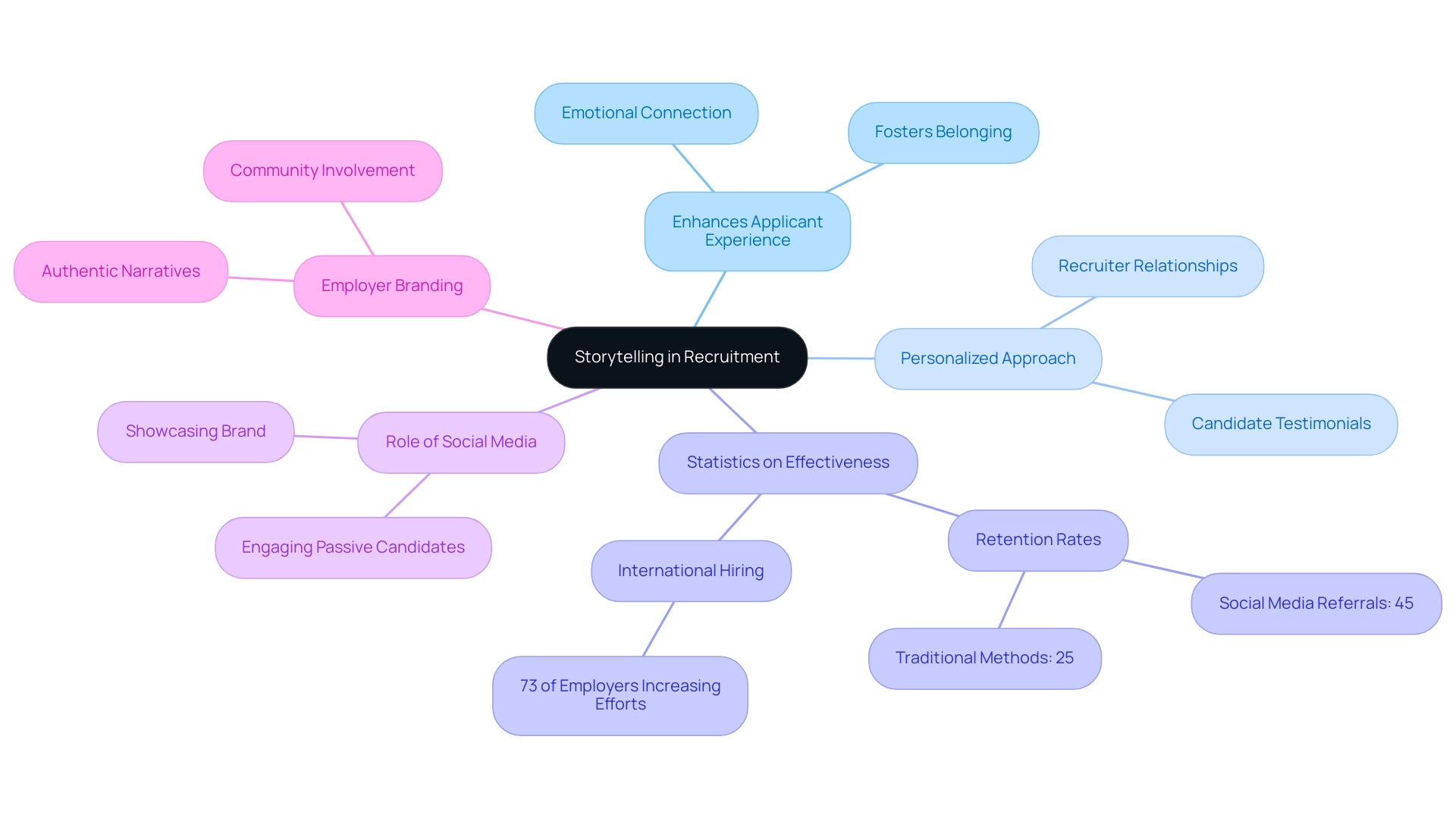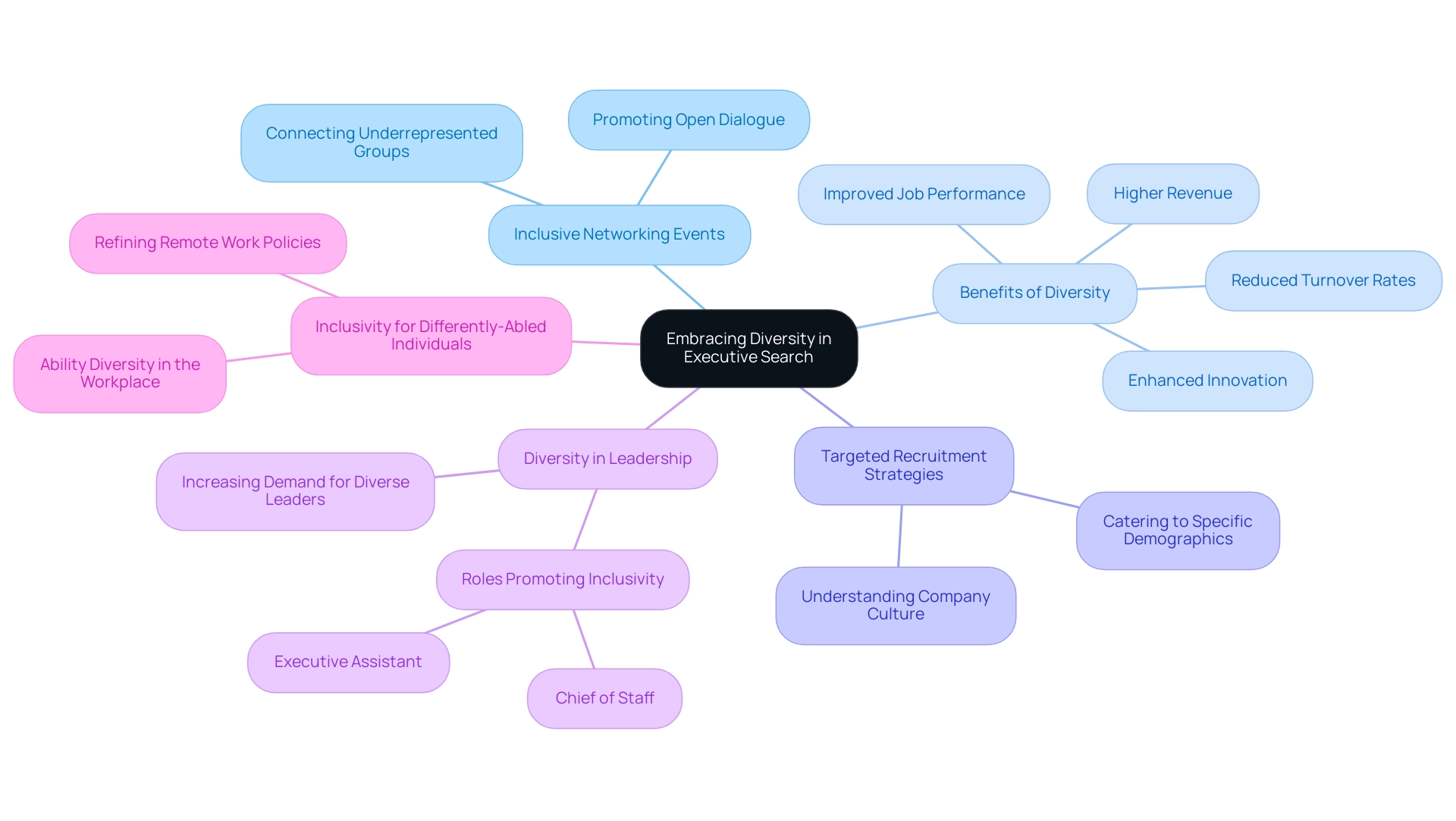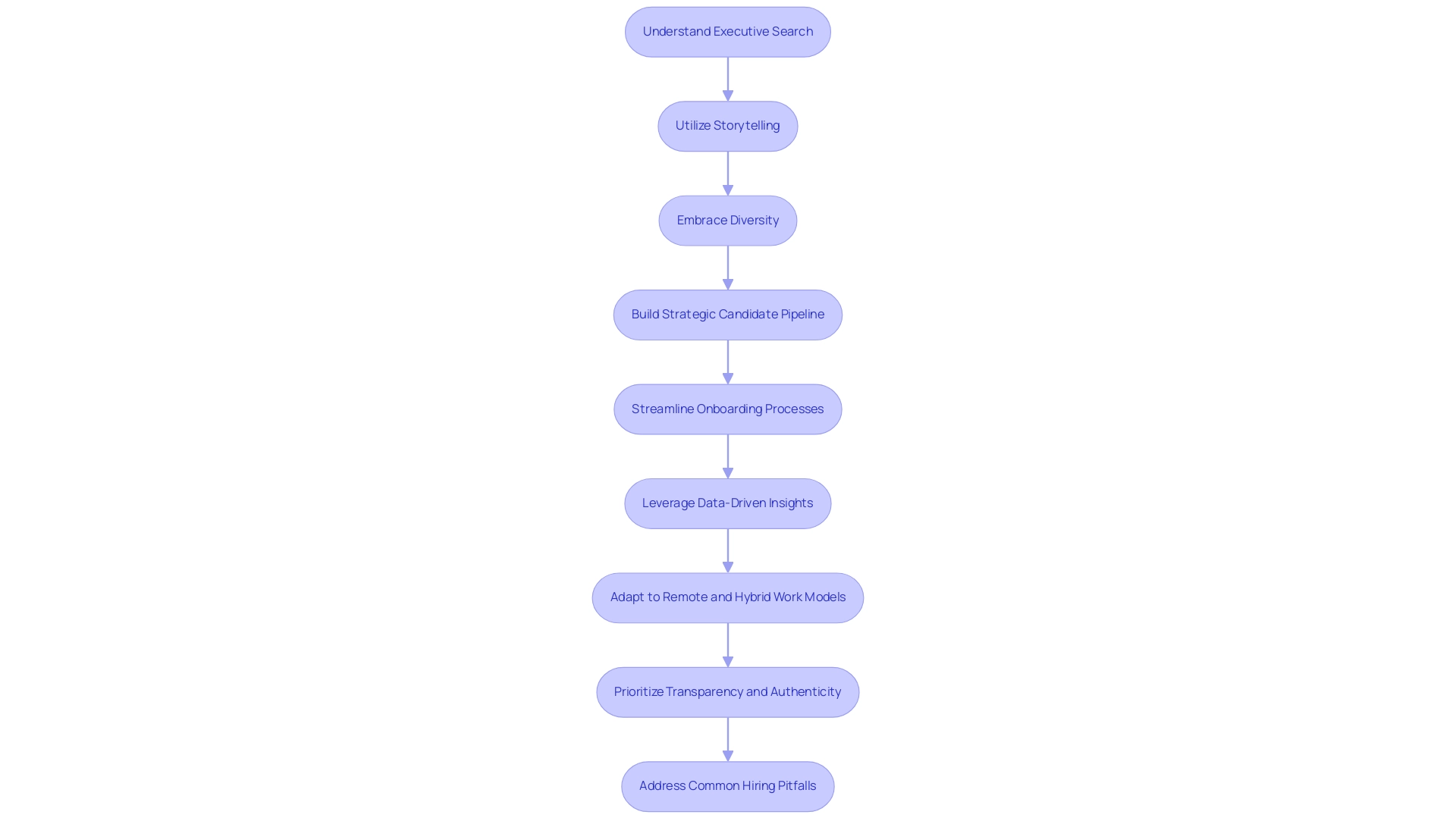Overview
Proven strategies for success in executive search job placement by 2025 encompass:
- Structured recruitment processes
- Inclusive networking
- Data-driven insights
Collectively, these elements significantly enhance hiring outcomes and candidate retention. Notably, organizations that implement these strategies experience a remarkable 30% higher success rate in filling leadership roles. This underscores the critical importance of aligning recruitment practices with the evolving expectations and values of the modern workforce.
Key Highlights:
- Executive search, or headhunting, focuses on identifying top-level executives aligned with organizational culture and goals, contrasting with traditional recruitment methods.
- Structured executive search strategies lead to a 30% higher success rate in filling leadership roles compared to conventional methods.
- Current trends emphasize the need for inclusive leadership teams and the growing significance of roles like Chief Sustainability Officers (CSOs) reflecting ethical practices.
- Storytelling in recruitment enhances candidate engagement, with a 45% retention rate for hires sourced through social media referrals using storytelling techniques.
- Inclusive networking events are crucial for diversifying the talent pool, with organizations having diverse leadership teams reporting 28% higher revenue.
- Strategic talent pipelining involves engaging potential candidates before job openings, fostering relationships that align with organizational needs.
- Streamlined onboarding processes are essential for new hires, with a structured approach significantly improving engagement and retention rates.
- Data-driven insights optimize recruitment strategies, with analytics revealing key performance indicators that enhance hiring outcomes.
- Organizations must adapt to remote and hybrid work models to attract a broader range of applicants, addressing modern workforce expectations.
Introduction
In the dynamic realm of talent acquisition, executive search stands out as an essential strategy for organizations striving to secure top-tier leadership. As companies grapple with an increasing scarcity of qualified executives, traditional recruitment methods are proving inadequate. This shift calls for a more sophisticated approach that emphasizes cultural fit and long-term objectives.
Boutique Recruiting is at the forefront of this evolution, harnessing profound industry insights and tailored strategies to connect exceptional candidates with organizations across the U.S. and Canada.
This article explores the complexities of executive search, underscoring the significance of:
- storytelling
- diversity
- strategic talent pipelining
- data-driven insights
in developing a successful recruitment process that meets the demands of today’s competitive market.
Understanding Executive Search: A Key to Talent Acquisition
Executive search, often referred to as headhunting, represents a specialized hiring process designed to identify and attract top-level executives. Boutique Recruiting excels in this domain, adeptly connecting high-quality individuals across diverse industries throughout the U.S. and Canada. In contrast to traditional recruitment methods that prioritize speed, executive search emphasizes sourcing individuals who not only possess the requisite skills but also resonate with the organization’s culture and long-term objectives.
This nuanced approach necessitates a comprehensive understanding of the client’s specific needs, prevailing industry trends, and the competitive landscape, ensuring that selected candidates are well-equipped to drive strategic initiatives effectively.
As we look toward 2025, the significance of a meticulously executed executive search job placement is underscored by the increasing scarcity of leadership talent across various sectors. Recent statistics reveal that organizations employing structured executive search strategies experience a 30% higher success rate in filling critical leadership roles compared to those relying on conventional methods. This trend highlights the necessity for companies to adapt their hiring strategies proactively, particularly in light of rapid changes in work environments and leadership demands.
Current trends in executive search recruitment emphasize the importance of building inclusive leadership teams and redefining retention strategies. As companies strive to create diverse and equitable workplaces, the role of Chief Sustainability Officers (CSOs) has gained prominence, reflecting a broader commitment to ethical practices and social responsibility. Industry experts assert that “Executive candidates are no longer solely motivated by compensation,” making it essential for recruiters like Boutique Recruiting to align their search processes with candidates’ values and organizational culture.
Case studies illustrate the effectiveness of these strategies. For instance, a recent initiative called ‘Preparing for the Future of Work‘ demonstrated how companies that invested in long-term workforce planning and leadership pathways were better prepared to address both current and future requirements. This proactive approach not only improves hiring results but also cultivates a resilient organizational framework capable of navigating the complexities of the modern business landscape.
In conclusion, conducting an effective executive search involves a strategic blend of understanding client needs, leveraging industry insights, and fostering relationships that prioritize cultural fit. As the landscape of talent acquisition continues to evolve, the significance of a well-executed executive search job placement remains paramount for entities seeking to secure top-tier leadership talent. Boutique Recruiting stands ready to be your partner in this endeavor. Reach out to discover more about our customized hiring solutions for roles such as Chief of Staff, Executive Assistant, and other essential positions across different sectors.
The Power of Storytelling in Attracting Candidates
Storytelling in recruitment has emerged as a transformative strategy, enabling organizations to effectively communicate their mission, values, and culture. By weaving authentic narratives about the company, its employees, and the meaningful impact of their work, recruiters can significantly enhance the applicant experience. This approach not only attracts individuals who align with the company’s narrative but also fosters a deeper sense of belonging and purpose among potential hires.
For instance, Amanda, a dedicated recruiter at Boutique Recruiting, exemplifies this personalized approach. With a Bachelor’s Degree in Human Resources from Northern Kentucky University, she has built a successful career by not only matching individuals with roles but also by fostering relationships that make them feel calm, understood, and confident before their interviews. Her dedication to matching professional firms with top talent is evident in the positive testimonials from those she has assisted.
Candidates like Magaly B. and Kate W. have praised the supportive and engaging experiences they had while working with Boutique Recruiting, highlighting how recruiters like Amanda guide them through the process and advocate for their best interests. Magaly B. stated, “Thanks for believing in me and helping me not short change myself,” while Kate W. expressed gratitude for Amanda’s immediate support and guidance.
Amanda’s efficiency in placements is noteworthy; she consistently meets or exceeds company expectations, ensuring that individuals are placed in roles that suit their skills and aspirations in a timely manner. Organizations that showcase employee success stories or highlight their community involvement can evoke emotional responses, making potential applicants more inclined to explore opportunities within the company. As storytelling gains traction in executive search, it is crucial for recruiters to develop narratives that genuinely reflect the organization’s core identity.
Statistics highlight the effectiveness of storytelling in hiring; individuals sourced via social media referrals, which frequently utilize storytelling techniques, show an impressive 45% retention rate, in contrast to only 25% for those brought in through conventional methods. This illustrates the power of engaging narratives in fostering long-term employee commitment. Additionally, with 73% of employers increasing their international hiring efforts, the need for compelling storytelling becomes even more critical in attracting diverse talent.
Furthermore, professional insights highlight that storytelling not only draws potential applicants but also improves their involvement throughout the hiring process. Anh Nguyen, a content creator and HR software reviewer, notes, “With a Business degree in one hand and a lifelong passion for writing in the other, I believe storytelling is essential in hiring to connect with individuals on a personal level.” This emphasizes the significance of addressing applicant concerns, especially considering the growing employee dissatisfaction with compensation structures, which can be alleviated through effective storytelling.
Furthermore, the role of social media in hiring cannot be overlooked. Utilizing storytelling effectively on these platforms allows companies to reach passive candidates and engage with potential hires while showcasing their brand. As the landscape of recruitment continues to evolve in 2025, embracing storytelling will be essential for executive search job placement, attracting top-tier individuals and ensuring a strong cultural fit.
When Amanda is not putting her heart and soul into finding others their long-term career path, she enjoys spending time outdoors with family and friends, traveling, and watching sports. She is extremely excited to be a part of the Boutique Recruiting team!
Embracing Diversity: The Role of Inclusive Networking Events
Inclusive networking events are pivotal in advancing diversity within the executive search landscape. These gatherings serve as vital platforms for underrepresented groups to connect with potential employers, significantly broadening the pool of skills. By prioritizing diversity and inclusion, entities can attract a more varied array of candidates, each bringing distinct perspectives and experiences that enrich the workplace.
For instance, hosting targeted events that cater to specific demographics or industries can effectively assist groups in identifying and engaging diverse talent. Such initiatives not only improve hiring efforts but also cultivate an inclusive environment that promotes open dialogue and collaboration among participants. This collaborative spirit is essential, as it often leads to innovative solutions and the formation of stronger, more cohesive teams.
As the demand for diverse leadership continues to escalate, embracing inclusive networking is no longer just a best practice; it has become a strategic necessity for executive search job placement 2025 firms like Boutique Recruiting. Statistics indicate that organizations with diverse leadership teams are 28% more likely to report higher revenue and improved job performance. This correlation underscores the importance of integrating diversity into recruitment strategies, particularly in executive search job placement 2025.
Moreover, case studies reveal that companies actively engaging in ability diversity—focusing on including differently-abled individuals—experience reduced turnover rates and enhanced innovation. These outcomes highlight the critical role that inclusive networking events play in shaping a diverse and effective workforce, ultimately driving organizational success in today’s competitive landscape.
Eric Eddy emphasizes this point, noting Boutique Recruiting’s ability to deliver top-notch talent quickly and efficiently, which is crucial in fostering a diverse talent pool. Testimonials from clients further demonstrate this commitment: “Boutique Recruiting has assisted our company in filling Accounting/Finance, Customer Service, and Technical Support positions, always presenting quality individuals,” shares Christina Delgado, Senior Talent Acquisition Specialist at SeaSpine. Additionally, HR leaders are expected to refine remote work policies to ensure inclusivity for employees with disabilities and caregivers, further aligning with the theme of diversity and inclusion in hiring.
Boutique Recruiting’s meticulous approach to understanding company culture and job requirements enables it to provide individuals who fit both technically and culturally within firms, reinforcing the significance of tailored hiring strategies in fostering diversity. Furthermore, roles such as Chief of Staff and Executive Assistant are essential in this context, as they often lead initiatives that promote inclusivity and operational excellence.
Strategic Talent Pipelining: Building a Future-Ready Candidate Pool
Strategic workforce pipelining represents a proactive recruitment approach, focusing on the identification and engagement of potential applicants prior to job openings. This method enables organizations to cultivate a pool of skilled individuals prepared to assume leadership roles as opportunities arise. By fostering relationships with these high-potential candidates through ongoing communication and engagement, recruiters can establish a dependable workforce pipeline that aligns with the organization’s evolving needs.
For instance, hosting informational webinars or networking events effectively maintains connections with prospective individuals, keeping them informed about the company’s developments and potential opportunities. This approach not only enhances participant involvement but also reinforces the organization’s commitment to cultivating a future-ready workforce. Boutique Recruiting exemplifies this strategy, having earned a reputation for delivering personalized hiring solutions across diverse industries, ensuring that candidates feel understood and confident throughout the recruitment process.
In today’s competitive job market, where 73% of companies acknowledge that well-defined job descriptions and clear expectations are vital for attracting potential hires, linking these elements to workforce pipelining becomes essential. By ensuring clarity in job descriptions and well-defined expectations, organizations can more effectively attract and engage top candidates, thereby enhancing their candidate pipelining efforts. Amanda, a dedicated recruiter at Boutique Recruiting, exemplifies this commitment by building relationships with applicants, ensuring they are well-prepared for interviews and aligned with the cultural dynamics of their prospective employers.
Organizations that successfully implement workforce pipelining strategies can anticipate higher success rates in their recruitment efforts, as they are better positioned to respond swiftly to leadership needs. Insights from industry leaders underscore the importance of a meticulous approach to understanding company culture and specific job requirements. This ensures that applicants not only meet technical qualifications but also fit seamlessly within the organizational environment.
As Eric Eddy noted, Boutique Recruiting’s ability to deliver exceptional talent swiftly and effectively highlights its proficiency in recruitment.
Moreover, while not directly tied to talent pipelining, it is noteworthy that 40% of companies prioritize mental health initiatives in their hiring practices. This trend reflects a broader understanding of the current recruitment landscape, further emphasizing the necessity for companies to adapt and innovate in their strategies to attract and retain talent.
For any inquiries or assistance, candidates and hiring managers are encouraged to reach out to Boutique Recruiting at (858) 800-4935. By checking the box on our contact form, you agree to receive text messages and emails from Boutique Recruiting at the provided number and email address, ensuring you remain informed about potential opportunities.
Streamlining Onboarding: Ensuring Smooth Transitions for New Hires
Streamlining the onboarding process is essential for facilitating a seamless transition for new hires into their roles. A well-structured onboarding program not only assists new executives in adjusting to the company culture but also establishes the foundation for their long-term success within the firm. Best practices for onboarding in 2025, particularly regarding executive search job placement, include pre-boarding activities that provide essential information and resources before the official start date. This proactive approach can significantly enhance the new hire’s initial experience.
- Assigning mentors or buddies to guide new hires through their first weeks is another effective strategy. This personal touch fosters a supportive environment, helping executives navigate their new roles with confidence.
- Furthermore, incorporating targeted training sessions that align with the company’s goals enables new executives to quickly grasp their responsibilities and expectations, ensuring they are well-prepared to contribute from day one.
The importance of a structured onboarding process cannot be overstated, particularly in light of recent findings that indicate 47% of HR professionals assert their companies do not evaluate onboarding processes, which is crucial for effective executive search job placement. This gap highlights a critical opportunity for improvement. Moreover, 65% of HR professionals believe that the integration of AI in onboarding will positively influence employee retention, underscoring the need for innovative approaches in this area.
Grace Lau, Director of Growth Content, mentions that ‘37.4% of HR professionals find remote onboarding to be the main challenge when filling a job position,’ highlighting the complexities companies encounter in this area. Statistics reveal that only 31% of employees describe their latest onboarding experience as ‘engaging,’ with just 32% finding it ‘exciting.’ This indicates a pressing need for companies to enhance their onboarding processes to foster greater engagement and excitement among new hires. The case study titled ‘Engagement in Onboarding Experiences’ supports this claim, emphasizing the necessity for companies to improve their onboarding practices.
By investing in a comprehensive onboarding experience, organizations can significantly boost employee engagement and retention, ultimately leading to a more productive workforce. As the global onboarding software market is projected to reach $1.7 billion by 2026, the emphasis on effective onboarding practices is more relevant than ever.
Leveraging Data-Driven Insights for Effective Recruitment
In the competitive landscape of executive search, leveraging data-driven insights is paramount for optimizing recruitment strategies. Organizations that harness analytics can uncover critical information about applicant behavior, market dynamics, and hiring outcomes. For instance, monitoring key performance indicators such as time-to-fill, quality of hire, and candidate satisfaction enables recruiters to pinpoint inefficiencies and enhance their processes.
Moreover, predictive analytics plays a vital role in anticipating future hiring needs by analyzing historical data, empowering organizations to proactively address potential workforce shortages. As the hiring landscape evolves, the integration of data-driven decision-making becomes essential for attracting and retaining top executive talent.
Statistics indicate that 83% of recruiters find job boards to be the most effective channel for high-volume recruiting, underscoring the importance of utilizing multiple data sources to inform hiring strategies. As Anh Nguyen, a content creator and HR software reviewer, notes, “an independent writer and a bad BUT wholeheartedly enthusiastic dancer,” the enthusiasm for data-driven approaches is crucial in today’s hiring environment. By adopting a comprehensive approach that includes data analytics, organizations can significantly improve their hiring outcomes, ensuring they secure the best candidates for executive roles.
Case studies demonstrate that firms employing data-driven hiring strategies not only enhance their efficiency in selecting candidates but also achieve better cultural fit and retention rates. Boutique Recruiting exemplifies this through its differentiation strategy, focusing on building lasting relationships and providing personalized service throughout the recruitment process. Amanda, a dedicated recruiter at Boutique Recruiting, is committed to pairing professional companies with top talent, ensuring placements are made efficiently while exceeding expectations.
Her meticulous approach to understanding company culture and specific job requirements allows her to deliver candidates who not only meet technical qualifications but also fit well within the organizational environment. Boutique Recruiting performs custom searches tailored to the unique needs of each client, specializing in roles such as Chief Technology Officer, HR Generalist, and other key positions across various industries. As industry leaders emphasize, the role of analytics in hiring is no longer optional; it is a critical component for success in executive search job placement 2025 and beyond.
Key Takeaways: Implementing Proven Strategies for Executive Search Success
To achieve success in executive search, organizations must prioritize several key strategies:
-
Understand the nuances of executive search: Recognizing the distinct challenges and opportunities within executive recruitment is crucial for effective personnel acquisition. This understanding allows firms to tailor their approaches to meet specific needs.
-
Utilize storytelling: Engaging candidates through compelling narratives about the company’s culture and values can significantly enhance their connection to the organization. This method not only draws skilled individuals but also cultivates a sense of belonging.
-
Embrace diversity: Hosting inclusive networking events expands the skills pool and promotes a diverse workforce. Companies that prioritize diversity in their hiring practices are better positioned to innovate and meet the needs of a varied client base.
-
Build a strategic candidate pipeline: Establishing a continuous flow of qualified individuals is essential. By proactively engaging with potential hires, organizations can reduce time-to-fill rates and ensure they have access to top talent when needed.
-
Streamline onboarding processes: A well-structured onboarding experience facilitates smooth transitions for new hires, enhancing retention rates and overall job satisfaction. Organizations that invest in effective onboarding see a marked improvement in employee engagement.
-
Leverage data-driven insights: Utilizing analytics to inform recruitment strategies can lead to better outcomes. For instance, the trend of rediscovering applicants from existing databases has proven effective, with 44% of hires in 2024 coming from companies’ CRM or ATS systems, a significant increase from 29.1% in 2021. This approach not only speeds up hiring processes but also reconnects individuals familiar with the company, as highlighted in the case study titled ‘Talent Rediscovery for Efficient Hiring.’
-
Adapt to remote and hybrid work models: Recognizing that remote and hybrid work models are essential for competitive hiring strategies is crucial in today’s job market. Organizations that embrace these models can attract a broader range of applicants and meet the evolving expectations of the workforce.
-
Prioritize transparency and authenticity: Candidates today are looking for genuine connections and clear communication during the hiring process. Organizations should encourage hiring managers to be transparent about company values and expectations, as this builds trust and helps applicants assess their fit within the organization. Additionally, individuals should be encouraged to explore multiple job offers and evaluate them against their career goals and values, ensuring they make informed decisions that align with their long-term aspirations.
-
Address common hiring pitfalls: Organizations must be aware of potential red flags during the hiring process, such as disorganization, excessive rescheduling, and lack of clarity in communication. By proactively addressing these issues, companies can enhance the applicant experience and improve their chances of attracting top talent.
By implementing these proven strategies, organizations can position themselves for success in the competitive landscape of executive search. The focus on aligning skills, ambitions, and values with organizational needs is paramount, as a career move is about finding a place where these elements align, not just about a new role. This alignment is further emphasized by the low offer acceptance rates, which suggest misalignment between job offers and applicant expectations.
As Eric Eddy noted, the ability to deliver top-notch candidates quickly and efficiently is a hallmark of effective recruitment, underscoring the importance of these strategies in achieving hiring goals.
Contact Boutique Recruiting to discuss your hiring needs and how we can help streamline the process to attract top-notch talent!
Conclusion
In the evolving landscape of executive search, organizations must adopt a multifaceted approach to secure top-tier leadership talent. The importance of understanding the unique challenges of executive recruitment, leveraging storytelling to engage candidates, and prioritizing diversity through inclusive networking events cannot be overstated. These practices not only broaden the talent pool but also foster a deeper connection between candidates and organizations, enhancing the overall hiring experience.
Moreover, building a strategic talent pipeline is essential for organizations to ensure a continuous flow of qualified candidates. This proactive method enables companies to respond swiftly to leadership needs, thereby reducing time-to-fill rates and enhancing recruitment outcomes. Coupled with streamlined onboarding processes, organizations can facilitate smoother transitions for new hires, ultimately boosting retention and employee satisfaction.
Finally, embracing data-driven insights is crucial for refining recruitment strategies. By utilizing analytics, organizations can make informed decisions that align with their goals and the evolving demands of the workforce. The integration of these strategies positions organizations to navigate the complexities of today’s talent acquisition landscape effectively.
As the competition for executive talent intensifies, adopting these proven strategies not only enhances recruitment success but also ensures that organizations are well-equipped for the future. Prioritizing alignment between candidate values and organizational culture is paramount, as this alignment fosters lasting relationships and drives overall success.
Frequently Asked Questions
What is executive search, and how does it differ from traditional recruitment?
Executive search, also known as headhunting, is a specialized hiring process aimed at identifying and attracting top-level executives. Unlike traditional recruitment methods that focus on speed, executive search prioritizes sourcing candidates who not only have the necessary skills but also fit the organization’s culture and long-term goals.
Why is a comprehensive understanding of client needs important in executive search?
A comprehensive understanding of client needs is crucial because it ensures that the selected candidates are well-equipped to drive strategic initiatives effectively. This understanding also helps in navigating industry trends and the competitive landscape.
What trends are influencing executive search recruitment as we approach 2025?
Trends include the increasing importance of building inclusive leadership teams, redefining retention strategies, and the rising prominence of roles such as Chief Sustainability Officers (CSOs). Companies are also recognizing that executive candidates are motivated by values beyond compensation.
How does structured executive search impact hiring success rates?
Organizations that employ structured executive search strategies experience a 30% higher success rate in filling critical leadership roles compared to those using conventional methods, highlighting the need for proactive hiring strategies.
What role does storytelling play in recruitment?
Storytelling in recruitment helps organizations communicate their mission, values, and culture effectively. It enhances the applicant experience by attracting candidates who resonate with the company’s narrative and fostering a sense of belonging.
Can you provide an example of a recruiter who utilizes storytelling effectively?
Amanda, a recruiter at Boutique Recruiting, exemplifies this approach by fostering relationships with candidates, ensuring they feel calm and confident before interviews. Her personalized support has received positive testimonials from candidates she has assisted.
What are the retention rates for candidates sourced through storytelling techniques?
Candidates sourced via social media referrals, which often utilize storytelling, show a retention rate of 45%, compared to only 25% for those brought in through traditional methods.
How is social media impacting the hiring process?
Social media allows companies to reach passive candidates and engage with potential hires while showcasing their brand. Effective storytelling on these platforms is critical for attracting diverse talent.
What is the overall significance of effective executive search and storytelling in recruitment?
Effective executive search is essential for securing top-tier leadership talent, while storytelling enhances the hiring process by attracting candidates who align with the organization’s values. Both strategies are vital for navigating the evolving landscape of talent acquisition.









